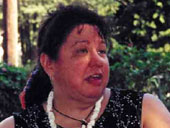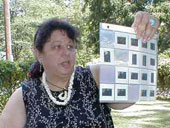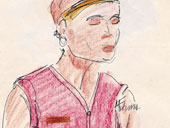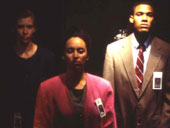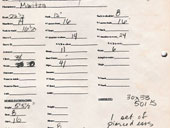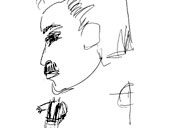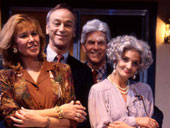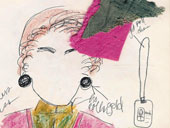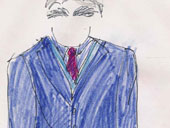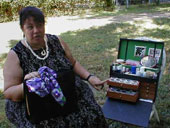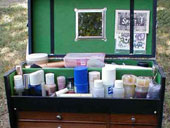Learning Library Segments
Joy Poth-Aleman
Primary Use of Medium: Theater & Film TransformationInterviewer: Donna Wetegrove
Interview Location This interview process takes place with Joy Poth-Aleman outside her home in east Austin on a breezy summer morning under the shade of a mammoth pecan tree. Neighbors, cars and even City tree shredder trucks make their way past her fenced in yard unnoticed by her dog, Honey, who feels the need to bark her acknowledgements at their every move!
Interview Date: 2.5.99
Writer: Donna Wetegrove
Inspiration
Art Form/Product
Green Aspects
Marketing Values
Special Offering
Additional Comments
Artist Profile
Inspiration
Girl Scouts is a really good thing because you learn how to do work on teams."What Type Of Artist/Musician Do You See Yourself As?
"Well, it's visual." Although performance art runs through Joy's veins, she has always been visual, being part of a visually organized family.
How Did You Get Here To This Place In Your Career?
"I have memories of going to my Grandmother's lake house and learning to tailor about the age of 7. I was learning how to do pad stitches and crocheting and all this really fine old southern hand skill things tatting and such. Interestingly enough, she was a buyer for Newman Marcus, giving us a textile thing in common, and she was a painter. So, I was in training even then. It use to really worry her that I would stay in to work on any little project to the point where it satisfied me, I wouldn't even go outside. So she would engage me with a lot of diversionary activities." Joy remembers taking walks in the woods while her Grandmother would point out different things they could use for experiments. "We dyed pillow cases one summer using poke berries which make purple, and poke berry leaves which make yellow brown's, I don't know what we used to make brown. I also made little doll clothes out of old pillowcases and was making my first lace edging to put on the trim. Although I didn't have to make massive amounts of anything, about 4 inches is a lot when you are a little kid. My Grandmother was really good about assisting me to create projects that I could complete. I think that's real important when you are a beginning artist to get to begin, middle and end a project, which is the whole deal for the artist."
"About age 7, I lived in a neighborhood where the woman across the street owned an advertising agency. When she would need somebody for a shot (photo shoot), she would walk around the neighborhood and round up kids. I started out in the Dallas summer musicals also at about seven, which was my first time to work the boards and be in an organized union house."
"Later, I was doing commercials for Southern Union Gas, the Dallas deliverer of utilities. I can't remember what else at that point but one thing led to another. I attended a summer course at the Dallas summer musicals and then the next thing I remember I was in high school. At that point, I was engaged in the technical side of theater because of art classes and painting. We were painting the drops because the high school owned them." (A drop is a large cloth, about 30 feet tall and 120 feet long that hangs at the back of a theater painted with a scene familiar to the event.)
While growing up, Joy's father was a general contractor, which gave her a whole different view of how projects were organized. "I got to see the construction guys, and I was frequently the invisible girl in the room. I would be listening to them carve up the city of Dallas. That kind of exposure from a very young age can teach you how to address different issues and be multifaceted in whatever kind of project you take on."
In college at North Texas, Joy worked as a directing performance major and added sketch artist to her growing list of accomplishments. "I have this tremendously classical trained background. When I went to college, I studied theater, both acting and directing. I completed an apprenticeship at the Dallas musicals where I had been performing. At that point, however, I was attached to the conductors unit and to the producers unit at the Dallas summer musical as the resident designer. After the show was done, I would go back and ask if they would have slides of the show somewhere. Frequently they wouldn't, so I would then have to do my drawings."
After following her friend Michael to Austin, they soon left Texas for the 13th Street Prop Shop in New York City, thanks to Michael's brother. "It was one of the union houses that built a lot of stuff. We were non-union Texas workers and they put up with us, taking us under their wings as student apprentices, but very unofficially. The guys tended to slip us money to make sure we were taken care of. We were a part of the scene and part of the workers, and it's really one of the places were I got a lot of hand skills out of those experiences. While I was up there, I had four permanent part time jobs at once working for some of the houses as a dresser." (A dresser assists actors during the run of a show to get in and out of their costumes and wigs.)
From New York, Joy then spent a few years working as a prop designer in Austin, where she became very strong in the Austin film community. About 7 or 8 years ago, she joined the local union in Austin. "Although it is not a guarantee as a hiring call, it is interesting and does pay well enough. When you get a union contract, the health and welfare benefits are enough that you really could work half a year and do really well in Austin. Some years there are 5 or 6 union jobs, and some years there are none." Presently, Joy remarks, "I am about film, now."
Regarding working in the film industry, Joy believes that you have to market yourself in a different way in order to pick up jobs. "I think that in the past, Texas especially and Austin, has been very passive and receiving whatever has shown up." Now, the Texas Film Commission is marketing itself in a new way, and are going to the Producers in Los Angeles. "For the last 2 years, we have gone out to L.A. and taken people to lunch from the studios. And when the studios come out to scout location, you take them to coffee or to lunch and you show them the state." The communication level between the union members has become more fluid this keeps the organization current with what's happening in the state.
Where Does Your Inspiration Come From?
"I think I probably learned everything that I need to know before about 12, and everything else is just a revisit to that. Of all the skills I use on the set, most, say 90%, are camping skills I learn in Girl Scouts. Girl Scouts are a really good thing because you learn how to do things like play on teams. Another similarity between scouts and filmmaking, is that both are really para-military, in the hierarchal structure and the assault on the day." Joy continues, clarifying similarities, "I have to assess what portion of that moment am I responsible for, what have I agreed to be responsible for and then there are things that I didn't necessarily agree to but am right there and it's falling apart, and by my interaction will stop it. So, there you are with your finger in the dyke saying, Okay guys, go and get the sand bags cause this is what will happen when I move my finger, really'." The skill required for this quick action comes full circle from lessons Joy learned as a youth.
Art Form/Product
"when I read something, I get visual images or colors. I don't design it it designs itself from the text."How Would You Describe Your Work Now And The Projects You Decide To Take On?
"They are bigger, geared to effect a lot more people by creating an industry hub here, in Austin."
For the last couple of years, Joy has been working with her union members structuring an apprentice program to install at Austin Community College. Currently, a crew is required to have 30 days experience which is difficult to achieve if you've never worked in the industry, it's a catch 22. As the interest of Texas as a production hub continues to grow, cultivating a new, educated workforce is paramount. This two year film program at Austin Community College will be structured to produce this labor. Modeled after Valencia College, Piedmont, and LA City Colleges, the program will enable students to graduate ready to start working.
Why Do You Like The Medium Of Film?
"Well, you know it is interesting. It comes out of the time when I was doing music videos and acting as a producer. What I really got out of some of those experiences is that I have all of this live performance experience. I have a huge track of live performance from the presenter's point of view and from the performer's point of view. I do not hesitate to tell someone You are nailing it, but it isn't on the tape yet'. I really respect live performance, but it's not the same thing as getting that quality or whatever that is that's riveting when it's on tape."
Film is always the same pressure only with film it seems like I've always got enough crew. That makes it not seem as hard when there is more hands to do the work. Film is like technical rehearsal, everyday. There are people who hardly survive theater because of the technical rehearsal day. But with film it's every bloody day. This is because each day is a different set and a different location. It doesn't repeat itself and it doesn't come into a whole. Film is always in bits and bits.
Does The Material Dictate The Design Or Does Your Design Dictate How The Material Is Used?
Joy's answer is both. "What I do is I fill myself with the text, fill myself with the project and then just go do it. Sometimes things change, but usually there are themes, and how that works for me is that when I read something I get visual images or colors. I don't design it, it designs itself from the text. The design is like channeling for me. I'm working off of somebody else's creation. Occasionally, I'll have a totally different take than the director, however. Then, I have to figure out what it is that he or she's wanting or envisioning and work from there."
Joy brings out photos to illustrate her work:
"This was Unmerciful Good Fortune. This was the most interesting show I think I have done in Austin theatrically. It was over at Hyde Park. What was interesting about this piece was it was really a mood piece. It was a story of a young woman who worked in a Mc Donald's and was accused of murder. When she would touch you, she could read your life and would kill those people whose lives were unattainable, by shaking their hands. You find out after the opening monologue every time she says "would you like fries with that" she's just poisoned somebody."
"I did the costuming for that piece. When I went to the first meeting with the director and then had gone to some of his rehearsals to look at the actors, I just selected a color palette from crayons. I like crayons because they don't smudge once you use them and you can approximate. Since there wasn't much of a budget, I decided to use fabric I already had, and dye it. The dyes are pretty easy to get the same colors as the crayons." After the palette was envisioned, Joy created drawings, and did the measurements. Having completed the design, Joy handed it over to somebody else to build. "It was the first time I had ever designed something, literally, left town and had another costumer, build it. The woman who built this stuff is incredible!"
"Another project I did while I was still doing plays was for the Texas Young Playwrights. This play was for a new for an emerging director, writer &, actor. What we had for each play was $30 it had no budget, which is a big part of the costuming world. You take as many short cuts as you can to get to the effect. You need to consider the camera angle because you will see it differently, and you don't have to go to the nth' degree as you would in real life."
What Brings Your Medium to Life?
"Brought it to life? Well, it's the movement and color. Those are some of my favorite fabrics to work with because of how they move."
Is There Any Detail or Element That Shows Up Consistently In Your Projects?
Ingenuity would be the best way to describe Joy's resourcefulness!
What Tools are required?
"The main tool is semantics, to a large degree. You make sure that you speak the same language as the rest of the crew. It changes from municipality to municipality, even in the same state. You really have to double check, what does that mean'."
Joy also has a make-up kit that travels with her. "It's a tool kit." It has got a big mobile mirror and many drawers full of stuff. "I have every color of humanoid basic and you mix them to get anything in between." When deciding what make-ups to use and have available, Joy emphasizes experience. "Being on set, seeing what people were using and what seems to last. The thing about these make-ups is that the pigment saturation in the foundation is really high, therefore, the color lasts a long time, and when you set it with powder, you don't have to re-do it all the time." This is not like sheer make-up, Joy continues, it's got a stuff that reflects the lights. It looks really heavy at first sight, she adds, but when you look at it under light and on camera it looks different, it is also different on stage. "In theater, you draw in the shadows to accentuate them because the lighting is much more static. You don't have anybody come in and bounce it or do any of the fill lighting."
Her tool kit also includes a large palette of lipsticks and a multitude of disposable applicators for all of her make-up. "I also must have a trashcan, because I'm going to be throwing stuff away."
Do you consider the projects that you do functional art and if so why?
"Functional art. That's a really good question. I think there is a yes and a no to that question. We've really gotten so wrapped up at the end of the 20th century and into the 21st century about science and reality. I just come back to being a visual processor, being a visual artist. When you look at the trail of visual arts through the last century - the impressionists, the cubists and then look at the leading thinking in science, it's always represented in art. The sciences are always represented in the visual arts because we're all talking to each other in the middle of the night at the coffeehouse. Well, not necessarily, but it seems like it. I think that the functionality of anything is really a question now. It think it's all in service. So functional ... hmmm."
"I think the art that I am involved in is critical and functional in the same way that one does proactive healthcare things. To have a healthy community you have to have a community that's willing to look at itself and learn about itself and learn about what human potentials are. That's what the performing arts do, we mirror and review opportunities and options and I know that that as a filmmaker."
Please Summarize Your Entire Process.
"A film takes about an hour and a half to two hours to read. In the beginning, I probably read it two or three times throughout the course of the day. It takes about the same amount of time to read it the first read as it does to see it. By the second time and the third time, I'll start making notes unless I just have to stop and make notes earlier than that. In the beginning stages, I won't have an idea about it, usually. When I finally do conceive the design, it comes when I'm doing something else, like washing dishes or driving, and all of the sudden everything lines up and I'll have ideas about a direction. I always want to understand the design before those design meetings with the rest of the team. However, I'm the last person to gel sometimes. If it comes first it's great because the rest of the team is going Oh, Ok.' That is really collaborative."
Do You Recommend What You Do As A Career Choice? Why?
"Well, actually I do. I think touring is a great thing to do in your 20's and even in your 30's, because you haven't settled into some place. You haven't invested thousands of dollars into a house or started a family. It's a great way to see the country and to see the world. If you are out on tour, I think wardrobe supers of AMB Broadway touring companies make $60,000 a year, and they don't have to pay any of that out for housing. When you're out on travel days they feed you!"
What Tips Might You Have For Someone New To The Medium? How Best To Develop Their Interest:
"I would call the Texas Film Commission hotline. There is always somebody in town working on a film with no budget and you could go and get your feet wet working for free - get involved.
Go volunteer at one of the local theaters"
"The truth is that there's not anybody in town that's training for touring, however."
Green Aspects
"I think that resource management is a really good description of what we do. We re-use often, bring it back."Please Point Out Any "Green" Aspects Of Your Process And Your Medium.
"I've worked with some mediums that were really, really toxic, like foam latex. I've done some puppet work with radio puppets that you have to cover with a skin that has to be baked in the oven. That puts off fumes in the air that will change 3 generations of children."
"I think that shoppers/buyers for the film industry frequently still hit the Goodwill's. You hit everything that you can find when you look for specific things."
Marketing Values
"I think of artists as developers; you develop your clientele and your market as much as you develop your project and your product."Please Talk About Making Multiples Of A Creative Effort As A Part Of Your Business.
"I usually don't have to make more than 6 of anything, ever, even if somebody is wearing something that has to be torn off of them or they get shot in it. You film it so you have how they look when you set the scene, and then in the process of its destruction."
"I actually had a line of clothing for a while, hated making a bazillion' of anything. I really like the original object making, but once I solve the puzzle, get me a new widget to work on!"
Where Do You See Your Creativity Evolving?
"I think that this time next year I'll have a studio space again that's just where I putter around. I don't know if I'll really go to painting but I think 2 dimensional visual expression is the direction I'm going back to. I was never really a drawer, more of a painter, painter/graphics kinds of stuff."
Special Offering
Teachers Joy is available to your classroom should they be interested in learning more about film and theater scene and prop design. Please contact TIPS on Art for coordination.Additional Comments
"I think it is critical for the young artist to do something like journaling. Write down everything because you can go back and review quarters or even years and discover some things about yourself, your interior dialogue, and see that we are more similar than we are different.""The skills that I use all the time that I learned in school are research skills. I use the library to learn the answers to my questions."
"I believe in the dignity of labor, and I believe that there's something really satisfying about working with your hands making products and objects.
Artist Profile:
Joy Poth-AlemanYou can contact Joy through TIPS On Art @ 512.288.4897
Thank you for utilizing TIPS On Art Learning Segments On The Web to further your understanding of the process of artists and art forms. Please take a few minutes to fill out our website survey. Through your feedback, and by making special requests of us for future segments, we will know how TIPS On Art has impacted your situation.

